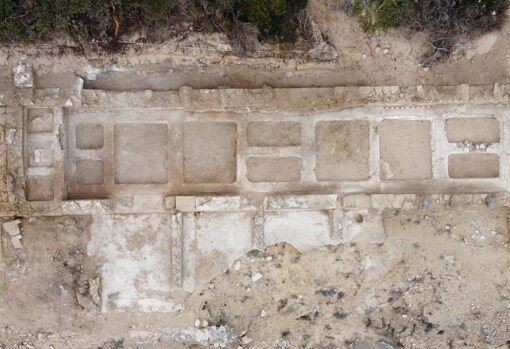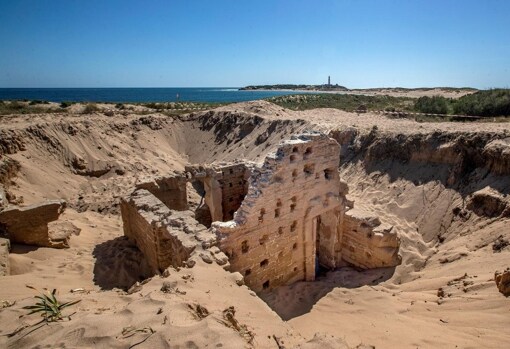Caños de Meca beach and the surroundings of Cape Trafalgar, in Barbate (Cádiz), were very different in the past from the natural area that currently attracts thousands of tourists. On the edge of the Atlantic existed in Roman times one of the most important Roman maritime villas found on the entire Andalusian coast and the only one known in the entire ancient Roman province of Baetica that combined aquaculture activities with production of the precious garum (a highly coveted fish sauce) and salted fish. And some time later, the works moved inland, to the beach. There, archaeologists from the University of Cadiz discovered last May some exceptional Roman baths and
They have just located two new buildings dedicated to the fishing-canning industry.
The latest research carried out by the Arqueostra team led by Darío Bernal-Casasola, Professor of Archeology, together with Professor José Juan Díaz Rodríguez, with the support of the Junta de Andalucía, show that the size of the maritime village was three times larger than they thought. “We have delimited the building in plan, which has 500 square meters, and we have excavated the half that corresponds to the productive areas of the salting pools,” explains Bernal-Casasola to ABC. The archaeological remains are in an excellent state of preservation. The thirteen Roman salting pools discovered to date, maintain their complete elevations (between 1.5 and 2 m deep on average), with complete crowning finishes, completely covered with hydraulic concrete (opus signinum).

On Los Caños beach, next to the Roman ‘balneum’ that preserves walls up to four meters high, they have found two new roman buildings Totally unknown until now, dedicated to the fishing-canning industry. The first cetaria, which has an area of about 150 square meters, was equipped with an L-shaped corridor in the open air, an area with 3 salting pools and a room for cleaning and cutting the fish. In the latter they found a large tuna cutting table of about 8 meters in length, with upper ashlar lining. “Only one other is known in the entire Mediterranean”, highlights the professor at the University of Cadiz, referring to the well-known Cotta factories in Mauretania Tingitana (environs of what is now Tangier). It is, therefore, unique in its kind in the entire Iberian Peninsula.
Archaeologists have documented the door and an access stairway to a second building with walls about two meters high and a large work area with sinks that is in good condition. With these new findings, only in the area of the Roman thermal complex the archaeological remains extend for between 1.5 and two hectares.
From the maritime village to the beach
“We still don’t know if the remains of the beach correspond to a town or a secondary center,” admits Bernal-Casasola, but the ongoing study “verifies the occupational continuity in the Roman site between the time of Augustus and the end of the 4th century or the beginning of the 5th century AD”. These novelties “have allowed fill a historical gap of more than 300 years“, as the researchers explain, since it was suggested that the Roman villa had been abandoned late in the 1st century AD Now they understand that “human occupation moved to the Caños de Meca beach, where the possible cetariae and annexed facilities , like the documented balneum, were in operation until shortly before the passage of the Vandals with Genseric through the Strait of Gibraltar (year 429 of the era)”.

The first archaeozoological analyzes of the terrestrial and marine fauna have also made it possible to locate a large shell midden from the Julio-Claudian period, where the Roman shellfish collectors discarded the remains of their catches. In it they have discovered mainly burgaillos, but also remains of oysters and mussels, which were possibly the object of breeding and fattening in the Roman nurseries of the town.
A deposit ten times larger
In the last campaign, carried out in the last two months, the researchers intended to delimit with mechanical and manual surveys the area of dispersion of the archaeological remains around Caños de Meca-Trafalgar to initiate the processes of their protection and their put in value. The results have brought these important archaeological surprises. “The area of the deposit has multiplied by ten”, indicates Bernal-Casasola.
During these field studies, geoarchaeological drilling has been carried out to reconstruct what the paleolandscape and paleotopography of the Cape Trafalgar tombolo could have been like, as well as the coastal lagoons that once surrounded the site, and whose resources were also used in ancient times. . Geophysical surveys have also been carried out to detect potential archaeological remains under the mantle of dunes that covers the entire area.

The interdisciplinary investigations, carried out by the University of Cádiz and by other collaborating institutions (University of Strasbourg and Center National de la Recherche Scientifique; and the German University of Marburg), have been carried out under the umbrella of a Specific Archaeological Activity approved by the Board of Andalusia and the research project ‘Arqueostra’ (‘Archeology of Roman oyster farming. Interdisciplinary techniques for determining the origins of aquaculture in Andalusia and Morocco’) in which a dozen researchers from the HUM-440 Research Group have participated . It has the authorization of the Breña y Marismas del Barbate Natural Park, through the Territorial Delegation of Sustainable Development of the Juna de Andalucía in Cádiz.
Their work will continue in spring and once the scientific investigations are finished, the objective is to value the remains so that they can be enjoyed by the public with a route through the archaeological landmarks of this paradisiacal place in Cadiz.
www.abc.es
George is Digismak’s reported cum editor with 13 years of experience in Journalism